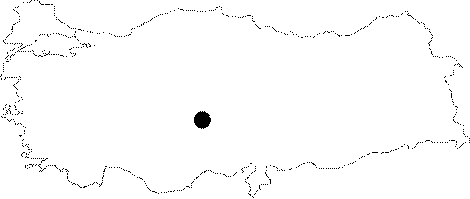|
©The Archaeological Settlements of Turkey - TAY Project
|
|
|
|
|
|
Bitlikeler |
|
|
For site maps and drawings please click on the picture...  |
For photographs please click on the photo...  |
|
Type:
|
Workshop |
|
Altitude:
|
1525 m |
|
Region:
|
Central Anatolia |
|
Province:
|
Nigde |
|
District:
|
Çiftlik |
|
Village:
|
Kayirli |
|
Investigation Method:
|
Survey |
|
Period:
|
|
|
|
|
 |
|
| Location: This workshop/atelier site lies in the Nigde province and in the Çiftlik municipality; on the slope east of the Kayirli Valley; across from the Ekinlik Plateau and on the Plateau itself [Cauvin - Balkan-Atli 1996:257]. In some publications the site is called Kayirli-Bitlikeler and Ekinlik [Balkan-Atli-Cauvin 1998:221]. |
| Geography and Environment: |
| History: |
| Research and Excavation: The site was discovered in 1993-95 during the obsidian surface survey conducted by a research team led by N. Balkan-Atli of the University of Istanbul; Faculty of Letters; Prehistory Section and by M.C. Cauvin of CNRS in the Aksaray; Nigde; Nevsehir Provinces. Another survey was conducted at the site in 1996. |
| Stratigraphy: |
| Small Finds: A wide range of artifacts including cores; cores prepared in different techniques; blades; bifacial obsidian blocks prepared for export were found. The technique used here resembles the one used in the nearby Kaletepe atelier-site. Several pyramidal cores with some with one striking platform and others cores with opposed platforms were found; indicating that the ateliers were used at different times by a number of different flint knappers. After analysis of the Bitlikeler material it is clear that the workshop focused on the blade technology as well as the production of pre-shaped blocks for export [Cauvin- Balkan-Atli 1996:257]. Analysis conducted by G. Deraprahamian yielded information on the chaine-operatoire and at the stages of core production at this site. The raw materials play an important role in the production of cores. The Neolithic chipped stone craftsmen prepared rectangular bifacial forms from the blocks they collected at the obsidian source. They then prepared striking platforms by careful direct percussion. Bipolar cores with flaking faces were prepared by removal of crested flakes. Later blades were removed. Cores were rejected when blades could no longer be removed from them or when cores were poorly knapped [Balkan-Atli-Cauvin 1998:221]. |
| Remains: |
| Interpretation and Dating: |